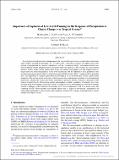Notice
This is not the latest version of this item. The latest version can be found at:https://dspace.mit.edu/handle/1721.1/133829.2
Importance of Laplacian of low-level warming for the response of precipitation to climate change over tropical oceans
| dc.contributor.author | Duffy, Margaret L | |
| dc.contributor.author | O’Gorman, Paul A | |
| dc.contributor.author | Back, Larissa E | |
| dc.date.accessioned | 2021-10-27T19:56:52Z | |
| dc.date.available | 2021-10-27T19:56:52Z | |
| dc.date.issued | 2020 | |
| dc.identifier.uri | https://hdl.handle.net/1721.1/133829 | |
| dc.description.abstract | <jats:title>Abstract</jats:title><jats:p>Several physical mechanisms have been proposed for projected changes in mean precipitation in the tropics under climate warming. In particular, the “wet-get-wetter” mechanism describes an amplification of the pattern of precipitation in a moister atmosphere, and the “warmer-get-wetter” mechanism describes enhanced upward motion and precipitation in regions where the increase in SST exceeds the tropical-mean increase. Studies of the current climate have shown that surface convergence over the tropical oceans is largely driven by horizontal gradients of low-level temperature, but the influence of these gradients on the precipitation response under climate warming has received little attention. Here, a simple model is applied to give a decomposition of changes in precipitation over tropical oceans in twenty-first-century climate model projections. The wet-get-wetter mechanism and changes in surface convergence are found to be of widespread importance, whereas the warmer-get-wetter mechanism is primarily limited to negative anomalies in the tropical southern Pacific. Furthermore, surface convergence is linked to gradients of boundary layer temperature using an atmospheric mixed layer model. Changes in surface convergence are found to be strongly related to changes in the Laplacian of boundary layer virtual temperature, and, to a lesser extent, the Laplacian of SST. Taken together, these results suggest that a “Laplacian-of-warming” mechanism is of comparable importance to wet get wetter and warmer get wetter for the response of precipitation to climate change over tropical oceans.</jats:p> | en_US |
| dc.language.iso | en | |
| dc.publisher | American Meteorological Society | en_US |
| dc.relation.isversionof | 10.1175/JCLI-D-19-0365.1 | en_US |
| dc.rights | Article is made available in accordance with the publisher's policy and may be subject to US copyright law. Please refer to the publisher's site for terms of use. | en_US |
| dc.source | American Meteorological Society (AMS) | en_US |
| dc.title | Importance of Laplacian of low-level warming for the response of precipitation to climate change over tropical oceans | en_US |
| dc.type | Article | en_US |
| dc.relation.journal | Journal of Climate | en_US |
| dc.eprint.version | Final published version | en_US |
| dc.type.uri | http://purl.org/eprint/type/JournalArticle | en_US |
| eprint.status | http://purl.org/eprint/status/PeerReviewed | en_US |
| dc.date.updated | 2021-09-17T16:41:57Z | |
| dspace.orderedauthors | Duffy, ML; O’Gorman, PA; Back, LE | en_US |
| dspace.date.submission | 2021-09-17T16:41:59Z | |
| mit.journal.volume | 33 | en_US |
| mit.journal.issue | 10 | en_US |
| mit.license | PUBLISHER_POLICY | |
| mit.metadata.status | Authority Work and Publication Information Needed | en_US |
| mit.metadata.status | Authority Work and Publication Information Needed |
